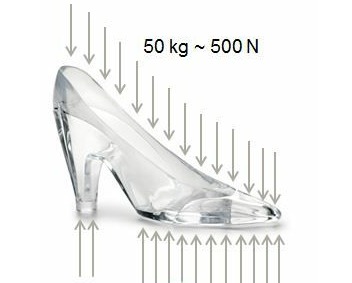Once upon a time,there lived a mechanical engineer who pondered a question that has bothered intelligent,curious children for years.Namely,what qualities would the glass in Cinderella's slippers need to have in order for her to walk and dance comfortably(and hold her weight)?
Yes,that was a question answered by one Antariksh Bothale,a BTech and MTech in Mechanical Engineering,on question and answer site Quora this week.
"It is delightful to have my masters degree in Mechanical Engineering put to use in resolving age old engineering problems,"wrote Bothale before giving a thorough mathematical breakdown of the problem.
The question made me smile because it's one I used to ask my parents all the time.After all…the risks seemed huge!What if the glass broke and sliced through her feet?It seemed like such a ridiculous choice of footwear."They were MAGIC glass slipers"my mother used to say,exasperated by my relentless story hole poking.But that just didn't cut it for me.Bothale's answer,however,does.
"Whenever we design something that needs to bear force,we test for various possible modes of failure and try to ensure that our object is strong against all of them,"he writes before undertaking an analysis of the compressive stress on the slippers arising from Cinderella's weight which he estimates at around 50kgs.
"I mean,her cousins were fat and ugly,so we have to leave them some room on the top,right?"he jokes.
Bothale starts by assuming Cinderella's weight can be applied uniformly across her shoe,and roughly estimates her foot size and overall foot area at A=0.015m squared.
If 50 kgs of weight were to be applied uniformly across this area,Bothale calculates that the compressive stress developed in the material would be:

Turns out it's good news for Cinderella and fairy tale purists alike then,because Bothale writes that the Yield strength of ordinary glass for compressive stress is approximately,which is three orders of magnitude more than what Cinderella's weight can produce.

Perfect.Or maybe not quite yet,because Cinderella doesn't just stand there looking pretty in her glass slippers,she actually has to walk around and dance,and that,points out Bothale,could lead to more compressive stress due to the bending moment applied to her heel every time she walks.
For simplicity's sake,Bothale makes a couple of assumptions.He gives Cinderella's heel a diameter of 2cm and a length of 6cm from the tip to the point where it joins the rest of the shoe.He then assumes her stepping angle to be about 30°,which would mean that only half of her weight would act in the normal direction to the heel.Plugging those numbers into his equation,Bothale calculates the maximum bending stress in the heel to a max of 19MPa,which he says is"dangerously close"to the critical stress level of 50MPa.
"Even if we make a few more allowances by making the heel thicker or the stepping angle smaller,we cannot let our little princess veer so dangerously close to disaster,"he writes.
And so,Bothale recommends using thermal toughened safety glass,with its yield strength of 200MPa and a higher Young's Modulus.
Even when the clock strikes midnight and Cinderella has to hightail it to her pumpkin carriage in those glass heels,increasing the impact force three to five times that of regular walking,Bothale calculates her dress would likely prevent her from making long strides,keeping her stepping angle within safe limits and ensuring the shoes don't shatter.Though he does say the princess to be would be"well-advised to develop a toe-first foot strike,which would totally solve the problem."
I don't know about happily ever after,but Bothale's attempt at solving the glass slipper conundrum certainly made my day.
What theoretical fairy tale problems would you like to see solved through engineering?Let us know in the comments section below.





